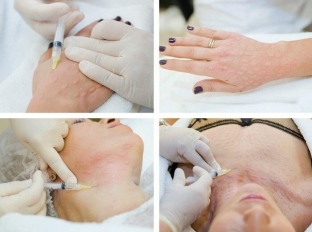In the body of each person there are cells of youth, on which it directly depends on how long he will maintain a young and attractive appearance. These cells are called fibroblasts, and they are located in the middle layer of the skin – dermis. After the age of 25, biological processes of aging start in the body, which affect absolutely all cells, including fibroblasts. Their performance decreases, the production of collagen, elastin and hyaluronic acid decreases, the skin loses firmness and elasticity, the first signs of aging appear. The most effective way to slow down the aging process and restore youth – This is SPRS therapy. How this technique helps to grow new skin – read on estet-portal.com right now.
The principle of SPRS therapy for effective skin rejuvenation
SPRS therapy – it is an effective skin rejuvenation technique based on the use of the patient's own fibroblasts.
A special preparation containing young fibroblast cells is injected into the skin of the problem area.
They are grown according to a patented technology from a small fragment of skin, approximately 3-5 mm in diameter, which is taken from the area least exposed to ultraviolet– behind the ear cavity. After the injection of only grown cells capable of dividing, the concentration of fibroblasts in the problem area increases, and thus the patient receives an absolutely "natural" rejuvenation effect.
SPRS Therapy:
- indications and contraindications for SPRS skin therapy;
- the main stages of the course of SPRS therapy;
- result after SPRS treatment.
Indications and contraindications for SPRS skin therapy
SPRS therapy can be indicated for patients who have any age-related changes in the skin of the face, neck, décolleté and even hands. In addition, this technique helps to cope with the consequences of acne, pigmentation, and is also used as a preparatory procedure before plastic surgery, as it promotes rapid healing of wounds. The following contraindications to SPRS therapy can be distinguished:
- oncological diseases;
- immunodeficiency conditions;
- exacerbation of acute and chronic diseases of the body;
- long history of hormonal therapy;
- pregnancy and lactation.

The main stages of the course of SPRS-therapy
The course of SPRS therapy takes place in several stages:
- Diagnostic stage: at this stage, the patient's fibroblasts are studied in the laboratory in order to draw up an individual program for correcting age-related changes.
- The laboratory stage takes about a month and a half and includes the process of growing fibroblasts for SPRS therapy in as close to biological conditions as possible.
- The last stage involves direct injection of grown fibroblasts in the amount that is not enough for a particular patient.
Result after SPRS therapy
After a course of SPRS-therapy, the patient receives a pronounced effect of rejuvenation: wrinkles are leveled, skin turgor and elasticity improve, tissues are tightened, and various imperfections are eliminated. The first effect can be assessed after the first treatment, but the standard course of SPRS therapy involves a minimum of two sessions with an interval of no more than six weeks.
Thanks to a strictly individual approach to the procedure, the patient receives a pronounced and absolutely safe effect of not only visual, but also structural skin rejuvenation.
SPRS therapy – it is a process of discovering and eliminating the true causes of aging, which is why patients who have tried this technique on themselves are absolutely satisfied with the result. Estet-portal.com recommends that you also check the effectiveness of SPRS therapy. Read more articles about anti-aging procedures on the website in the "Cosmetology" section.







Add a comment